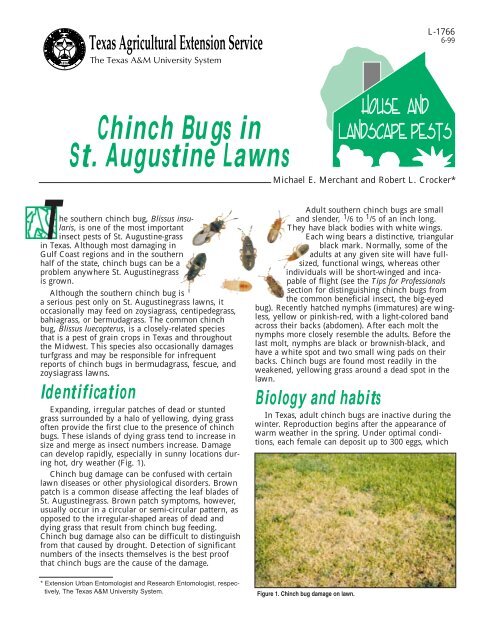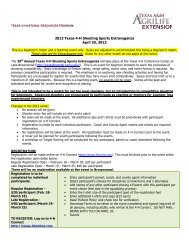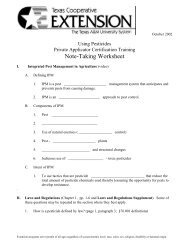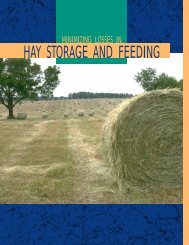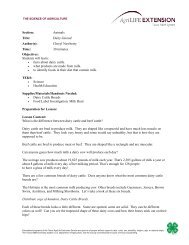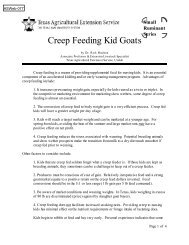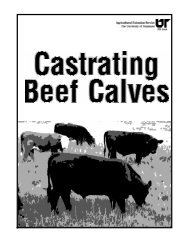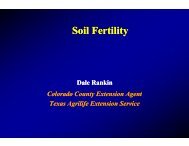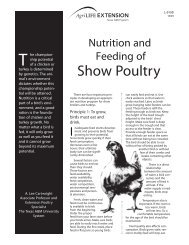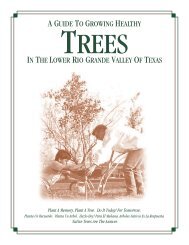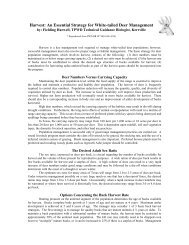Chinch Bugs in St. Augustine Grass - The Urban Rancher - Texas ...
Chinch Bugs in St. Augustine Grass - The Urban Rancher - Texas ...
Chinch Bugs in St. Augustine Grass - The Urban Rancher - Texas ...
Create successful ePaper yourself
Turn your PDF publications into a flip-book with our unique Google optimized e-Paper software.
L-1766<br />
6-99<br />
<strong>Ch<strong>in</strong>ch</strong> <strong>Bugs</strong> <strong>in</strong><br />
<strong>St</strong>. August<strong>in</strong>e Lawns<br />
Michael E. Merchant and Robert L. Crocker*<br />
<strong>The</strong> southern ch<strong>in</strong>ch bug, Blissus <strong>in</strong>sularis,<br />
is one of the most important<br />
<strong>in</strong>sect pests of <strong>St</strong>. August<strong>in</strong>e-grass<br />
<strong>in</strong> <strong>Texas</strong>. Although most damag<strong>in</strong>g <strong>in</strong><br />
Gulf Coast regions and <strong>in</strong> the southern<br />
half of the state, ch<strong>in</strong>ch bugs can be a<br />
problem anywhere <strong>St</strong>. August<strong>in</strong>egrass<br />
is grown.<br />
Although the southern ch<strong>in</strong>ch bug is<br />
a serious pest only on <strong>St</strong>. August<strong>in</strong>egrass lawns, it<br />
occasionally may feed on zoysiagrass, centipedegrass,<br />
bahiagrass, or bermudagrass. <strong>The</strong> common ch<strong>in</strong>ch<br />
bug, Blissus luecopterus, is a closely-related species<br />
that is a pest of gra<strong>in</strong> crops <strong>in</strong> <strong>Texas</strong> and throughout<br />
the Midwest. This species also occasionally damages<br />
turfgrass and may be responsible for <strong>in</strong>frequent<br />
reports of ch<strong>in</strong>ch bugs <strong>in</strong> bermudagrass, fescue, and<br />
zoysiagrass lawns.<br />
Identification<br />
Expand<strong>in</strong>g, irregular patches of dead or stunted<br />
grass surrounded by a halo of yellow<strong>in</strong>g, dy<strong>in</strong>g grass<br />
often provide the first clue to the presence of ch<strong>in</strong>ch<br />
bugs. <strong>The</strong>se islands of dy<strong>in</strong>g grass tend to <strong>in</strong>crease <strong>in</strong><br />
size and merge as <strong>in</strong>sect numbers <strong>in</strong>crease. Damage<br />
can develop rapidly, especially <strong>in</strong> sunny locations dur<strong>in</strong>g<br />
hot, dry weather (Fig. 1).<br />
<strong>Ch<strong>in</strong>ch</strong> bug damage can be confused with certa<strong>in</strong><br />
lawn diseases or other physiological disorders. Brown<br />
patch is a common disease affect<strong>in</strong>g the leaf blades of<br />
<strong>St</strong>. August<strong>in</strong>egrass. Brown patch symptoms, however,<br />
usually occur <strong>in</strong> a circular or semi-circular pattern, as<br />
opposed to the irregular-shaped areas of dead and<br />
dy<strong>in</strong>g grass that result from ch<strong>in</strong>ch bug feed<strong>in</strong>g.<br />
<strong>Ch<strong>in</strong>ch</strong> bug damage also can be difficult to dist<strong>in</strong>guish<br />
from that caused by drought. Detection of significant<br />
numbers of the <strong>in</strong>sects themselves is the best proof<br />
that ch<strong>in</strong>ch bugs are the cause of the damage.<br />
Adult southern ch<strong>in</strong>ch bugs are small<br />
and slender, 1 /6 to 1 /5 of an <strong>in</strong>ch long.<br />
<strong>The</strong>y have black bodies with white w<strong>in</strong>gs.<br />
Each w<strong>in</strong>g bears a dist<strong>in</strong>ctive, triangular<br />
black mark. Normally, some of the<br />
adults at any given site will have fullsized,<br />
functional w<strong>in</strong>gs, whereas other<br />
<strong>in</strong>dividuals will be short-w<strong>in</strong>ged and <strong>in</strong>capable<br />
of flight (see the Tips for Professionals<br />
section for dist<strong>in</strong>guish<strong>in</strong>g ch<strong>in</strong>ch bugs from<br />
the common beneficial <strong>in</strong>sect, the big-eyed<br />
bug). Recently hatched nymphs (immatures) are w<strong>in</strong>gless,<br />
yellow or p<strong>in</strong>kish-red, with a light-colored band<br />
across their backs (abdomen). After each molt the<br />
nymphs more closely resemble the adults. Before the<br />
last molt, nymphs are black or brownish-black, and<br />
have a white spot and two small w<strong>in</strong>g pads on their<br />
backs. <strong>Ch<strong>in</strong>ch</strong> bugs are found most readily <strong>in</strong> the<br />
weakened, yellow<strong>in</strong>g grass around a dead spot <strong>in</strong> the<br />
lawn.<br />
Biology and habits<br />
In <strong>Texas</strong>, adult ch<strong>in</strong>ch bugs are <strong>in</strong>active dur<strong>in</strong>g the<br />
w<strong>in</strong>ter. Reproduction beg<strong>in</strong>s after the appearance of<br />
warm weather <strong>in</strong> the spr<strong>in</strong>g. Under optimal conditions,<br />
each female can deposit up to 300 eggs, which<br />
* Extension <strong>Urban</strong> Entomologist and Research Entomologist, respectively,<br />
<strong>The</strong> <strong>Texas</strong> A&M University System.<br />
Figure 1. <strong>Ch<strong>in</strong>ch</strong> bug damage on lawn.
hatch <strong>in</strong> about 2 weeks. <strong>The</strong> nymphal stage lasts<br />
about 30 days (less dur<strong>in</strong>g hot weather), while the<br />
entire life cycle lasts 7 to 8 weeks. This speed of<br />
development allows time for three to five ch<strong>in</strong>ch bug<br />
generations each year. However, as the season progresses<br />
generations tend to overlap heavily, with the<br />
result that all stages normally are found together.<br />
Mouthparts of the southern ch<strong>in</strong>ch bug consist of a<br />
long, slender beak, which is held close to the midl<strong>in</strong>e<br />
of the underside of the <strong>in</strong>sect when not feed<strong>in</strong>g.<br />
<strong>Ch<strong>in</strong>ch</strong> bug damage is due not just to the direct<br />
effects of feed<strong>in</strong>g, but also to phytotoxic effects of the<br />
saliva.<br />
Manag<strong>in</strong>g ch<strong>in</strong>ch bugs<br />
Cultural controls<br />
Control of ch<strong>in</strong>ch bugs starts with proper lawn<br />
care. Keep<strong>in</strong>g thatch to a m<strong>in</strong>imum, for example,<br />
reduces ch<strong>in</strong>ch bug numbers and makes other control<br />
methods more effective. Thatch is the layer of dead<br />
plant material found between the green tops of the<br />
grass plant and the soil below. Thatch provides a protective<br />
home for ch<strong>in</strong>ch bugs, and chemically b<strong>in</strong>ds<br />
with many <strong>in</strong>secticides, mak<strong>in</strong>g such controls less<br />
effective.<br />
Excessive thatch forms when soil microbes are<br />
unable to break down dead plant material as fast as it<br />
is added. Proper mow<strong>in</strong>g practices can help reduce<br />
thatch build up. For optimum turfgrass health, no<br />
more than 35 to 40 percent of the leaf blade should<br />
be removed at a time when mow<strong>in</strong>g. This means that<br />
lawns generally should be mowed no less often than<br />
once a week dur<strong>in</strong>g the grow<strong>in</strong>g season. Mulch<strong>in</strong>g- or<br />
recycl<strong>in</strong>g-type mowers tear grass clipp<strong>in</strong>gs <strong>in</strong>to small<br />
pieces that are decomposed more easily by soil<br />
microbes. Research has shown that proper use of<br />
mulch<strong>in</strong>g mowers reduces the need for fertilizers and<br />
does not contribute to excessive thatch.<br />
When thatch exceeds 1 <strong>in</strong>ch <strong>in</strong> thickness, it may be<br />
necessary to have your lawn “vertically mowed.”<br />
Vertical mow<strong>in</strong>g (a method of physically remov<strong>in</strong>g<br />
thatch) can be performed by a professional lawn<br />
ma<strong>in</strong>tenance company or by do<strong>in</strong>g it yourself. Vertical<br />
mow<strong>in</strong>g can temporarily harm your lawn’s appearance<br />
because it destroys the tightly woven stolon system<br />
of <strong>St</strong>. August<strong>in</strong>egrass. Vertical mowers can be<br />
obta<strong>in</strong>ed through many equipment rental stores.<br />
Lawn aeration, <strong>in</strong> comb<strong>in</strong>ation with top-dress<strong>in</strong>g,<br />
also can help reduce thick layers of thatch. Aeration is<br />
performed by punch<strong>in</strong>g holes <strong>in</strong> the turf to <strong>in</strong>crease<br />
air and water penetration. Lawn aeration mach<strong>in</strong>es<br />
can be obta<strong>in</strong>ed from many equipment rental stores,<br />
or aeration can be performed by a professional lawn<br />
care company. Aeration, <strong>in</strong> comb<strong>in</strong>ation with topdress<strong>in</strong>g,<br />
helps correct moderate thatch problems by<br />
<strong>in</strong>creas<strong>in</strong>g soil-to-thatch contact, thus speed<strong>in</strong>g up<br />
microbial decay. For more <strong>in</strong>formation about ma<strong>in</strong>ta<strong>in</strong><strong>in</strong>g<br />
<strong>St</strong>. August<strong>in</strong>egrass lawns, see <strong>Texas</strong><br />
Agricultural Extension Service publication B-5088,<br />
“Home Lawns.”<br />
Over-application of fertilizer also contributes to<br />
thatch formation and makes lawns more attractive as<br />
a food source for ch<strong>in</strong>ch bugs. No more than 3 to 4<br />
pounds of nitrogen (N) per 1,000 square feet should<br />
be applied each year to <strong>St</strong>. August<strong>in</strong>egrass grow<strong>in</strong>g <strong>in</strong><br />
sunny locations. <strong>Grass</strong> <strong>in</strong> shady sites needs no more<br />
than 2 pounds of nitrogen per 1,000 square feet each<br />
year. Organic, or slow-release fertilizers, reduce the<br />
risk of over-fertilization because they release nitrogen<br />
more slowly. Local nursery professionals or your<br />
Extension Service office can provide more <strong>in</strong>formation<br />
on determ<strong>in</strong><strong>in</strong>g the proper amount of fertilizer to<br />
use <strong>in</strong> your lawn.<br />
Too little or too much water also can cause ch<strong>in</strong>ch<br />
bug problems. <strong>Ch<strong>in</strong>ch</strong> bugs prefer hot, dry environments.<br />
Dry weather enhances survival of ch<strong>in</strong>ch bug<br />
nymphs and eggs by reduc<strong>in</strong>g the <strong>in</strong>cidence of disease.<br />
Also, drought-stressed lawns are more susceptible<br />
to ch<strong>in</strong>ch bug <strong>in</strong>jury. On the other hand, overwater<strong>in</strong>g<br />
results <strong>in</strong> saturated, oxygen-deprived soils<br />
that cannot susta<strong>in</strong> the microbes needed to decompose<br />
thatch.<br />
<strong>St</strong>. August<strong>in</strong>egrass lawns should be watched closely<br />
dur<strong>in</strong>g the summer for signs of drought stress. <strong>The</strong><br />
lawn should be watered immediately when edges of<br />
grass blades beg<strong>in</strong> to curl, grass fails to spr<strong>in</strong>g back<br />
quickly when walked on, or the turf takes on a dull<br />
bluish-gray color. Due to the variety of soil types and<br />
depths <strong>in</strong> <strong>Texas</strong>, the amount of water needed will<br />
vary. Whenever possible, apply enough water to wet<br />
the soil profile to a depth of approximately 6 <strong>in</strong>ches<br />
and let it dry out between irrigations. Frequent water<strong>in</strong>g<br />
promotes shallow root systems <strong>in</strong> <strong>St</strong>. August<strong>in</strong>egrass,<br />
mak<strong>in</strong>g it more susceptible to <strong>in</strong>jury by ch<strong>in</strong>ch<br />
bugs.<br />
Resistant varieties<br />
<strong>The</strong> most commonly planted <strong>St</strong>. August<strong>in</strong>e-grass<br />
varieties (<strong>in</strong>clud<strong>in</strong>g ‘<strong>Texas</strong> common’ and ‘Raleigh’) are<br />
highly susceptible to ch<strong>in</strong>ch bug attack; however,<br />
research has identified several resistant types. <strong>The</strong><br />
varieties ‘Floratam’, ‘Floralawn’, and ‘Florat<strong>in</strong>e’ show<br />
vary<strong>in</strong>g degrees of resistance to feed<strong>in</strong>g by ch<strong>in</strong>ch<br />
bugs. ‘Floratam’, however, is the only variety that is<br />
commonly sold <strong>in</strong> <strong>Texas</strong>. ‘Floratam’ generally provides<br />
a high level of resistance to both ch<strong>in</strong>ch bugs and <strong>St</strong>.<br />
August<strong>in</strong>e decl<strong>in</strong>e (SAD), a virus disease; however, it<br />
should be planted only <strong>in</strong> the southern half of the<br />
<strong>Texas</strong> because of its lack of cold-hard<strong>in</strong>ess. Residents<br />
of counties north of Houston and San Antonio should<br />
check with their local county Extension office to<br />
determ<strong>in</strong>e whether ‘Floratam’ is appropriate for their<br />
area.<br />
Biological control<br />
<strong>Ch<strong>in</strong>ch</strong> bugs are attacked by many predatory<br />
<strong>in</strong>sects, such as big-eyed bugs (Geocoris spp.), m<strong>in</strong>ute<br />
pirate bugs (Xylocoris spp.), and ants. Repeated <strong>in</strong>secticide<br />
applications can reduce populations of beneficial<br />
organisms and actually lead to <strong>in</strong>creased ch<strong>in</strong>ch<br />
bug numbers. To preserve beneficial <strong>in</strong>sects, apply<br />
<strong>in</strong>secticides only when necessary.<br />
2
Figure 3. Southern ch<strong>in</strong>ch bug on <strong>St</strong>. August<strong>in</strong>e grass blade.<br />
New varieties of <strong>in</strong>sect-pathogenic fungi are currently<br />
be<strong>in</strong>g selected and tested for ch<strong>in</strong>ch bug control.<br />
Beauveria bassiana is one such fungus that has<br />
shown potential for control of many pests. Currently,<br />
however, there are no consistently effective fungal<br />
controls for ch<strong>in</strong>ch bug. Likewise, beneficial nematodes<br />
have provided <strong>in</strong>consistent results when used<br />
aga<strong>in</strong>st ch<strong>in</strong>ch bugs. For homeowners who want to<br />
avoid the use of any chemicals on their lawn, these<br />
products may provide some measure of control.<br />
Chemical control<br />
Good water and fertility management, thatch control,<br />
and use of resistant grass varieties dramatically<br />
reduce the need for <strong>in</strong>secticides to control ch<strong>in</strong>ch<br />
bugs. However, when dead and dy<strong>in</strong>g zones <strong>in</strong> turfgrass<br />
are accompanied by the presence of ch<strong>in</strong>ch<br />
bugs, some corrective action is needed. Chemical<br />
<strong>in</strong>secticides, when used accord<strong>in</strong>g to label directions,<br />
can provide a rapid reduction <strong>in</strong> ch<strong>in</strong>ch bug numbers.<br />
<strong>The</strong> first step when us<strong>in</strong>g pesticides for ch<strong>in</strong>ch bug<br />
control is to determ<strong>in</strong>e whether a problem truly<br />
exists. If your neighborhood is prone to ch<strong>in</strong>ch bug<br />
problems, <strong>in</strong>spect your lawn weekly dur<strong>in</strong>g the<br />
spr<strong>in</strong>g, summer and fall months. Look for off-color<br />
areas, especially <strong>in</strong> direct sun, and along sidewalks<br />
and driveways. When ch<strong>in</strong>ch bugs are present <strong>in</strong> high<br />
enough numbers to cause grass to yellow, they can<br />
often be found by part<strong>in</strong>g the grass at the edge of<br />
affected areas and exam<strong>in</strong><strong>in</strong>g the soil and base of the<br />
turf (see Tips for Professionals section). Several checks<br />
should be made <strong>in</strong> areas with suspected <strong>in</strong>festations.<br />
With heavy <strong>in</strong>festations, small numbers of ch<strong>in</strong>ch<br />
bugs may be seen walk<strong>in</strong>g on leaves or scurry<strong>in</strong>g<br />
about on adjacent sidewalks on hot days.<br />
When ch<strong>in</strong>ch bugs are abundant enough to cause<br />
visible damage, <strong>in</strong>secticide use can prevent further<br />
<strong>in</strong>jury. A variety of liquid and granular <strong>in</strong>secticides is<br />
available to control ch<strong>in</strong>ch bugs. Granular <strong>in</strong>secticides<br />
can be applied with a standard fertilizer spreader and<br />
irrigated lightly ( 1 /8 to 1 /4 <strong>in</strong>ch of water) to activate<br />
the <strong>in</strong>secticide. Drop-type spreaders are recommended<br />
to avoid scatter<strong>in</strong>g <strong>in</strong>secticide granules <strong>in</strong>to gutters,<br />
sidewalks and driveways, where the granules<br />
can be washed <strong>in</strong>to storm dra<strong>in</strong>s and streams. Any<br />
granules land<strong>in</strong>g <strong>in</strong> such sites should be swept up and<br />
reapplied properly.<br />
Liquid sprays are usually applied us<strong>in</strong>g a hose-end<br />
sprayer that can apply 15 to 20 gallons of water per<br />
1,000 square feet. To ensure even coverage, spray<br />
back and forth across the same area. Irrigation is not<br />
recommended follow<strong>in</strong>g application of liquid <strong>in</strong>secticides.<br />
Water<strong>in</strong>g the lawn before application can help<br />
the pesticide penetrate <strong>in</strong>to the turf.<br />
In cases where ch<strong>in</strong>ch bugs are restricted to isolated<br />
areas of the lawn, use spot treatments. Treat the<br />
off-color turf and all surround<strong>in</strong>g <strong>in</strong>fested areas.<br />
Inspect the site every 3 to 5 days for at least 2 weeks<br />
to determ<strong>in</strong>e if the <strong>in</strong>festation is under control. Spot<br />
treatments m<strong>in</strong>imize the impact of pesticides on beneficials<br />
and help avoid environmental contam<strong>in</strong>ation.<br />
Products conta<strong>in</strong><strong>in</strong>g diaz<strong>in</strong>on, chlorpyrifos<br />
(Dursban®), or acephate (Orthene®) are suggested for<br />
homeowner applications. <strong>Ch<strong>in</strong>ch</strong> bugs have been<br />
reported with resistance to the above products <strong>in</strong><br />
some areas of Florida; however, this has not been<br />
apparent <strong>in</strong> <strong>Texas</strong>. Where any of these products fail to<br />
provide control, apply a synthetic pyrethroid such as<br />
permethr<strong>in</strong> (e.g., Spectra-cide® Liquid Insecticide<br />
Spray).<br />
Safety precautions<br />
Always wear appropriate cloth<strong>in</strong>g when apply<strong>in</strong>g<br />
pesticides. Read the label to see what protective<br />
equipment should be worn. M<strong>in</strong>imal protective cloth<strong>in</strong>g<br />
<strong>in</strong>cludes long pants, shirt, shoes and socks.<br />
Unl<strong>in</strong>ed, chemical-resistant gloves are recommended<br />
whenever mix<strong>in</strong>g liquid pesticides. Treated areas<br />
should be allowed to dry thoroughly before permitt<strong>in</strong>g<br />
people or pets to walk or play on the treated<br />
grass. Always check the label for <strong>in</strong>formation concern<strong>in</strong>g<br />
safe re-entry times.<br />
Some communities <strong>in</strong> <strong>Texas</strong> experience periodic<br />
sewage contam<strong>in</strong>ation due to improper pesticide use<br />
and disposal. Check label directions for special<br />
<strong>in</strong>structions on disposal of empty conta<strong>in</strong>ers. Never<br />
dispose of unused pesticides down storm sewers, toilets,<br />
or s<strong>in</strong>ks. This pollutes the environment and can<br />
result <strong>in</strong> costly cleanups for your community. Clean<br />
up pesticide spills immediately. Should any pesticide<br />
threaten to enter a storm dra<strong>in</strong>, stream, or lake, call<br />
the <strong>Texas</strong> <strong>St</strong>ate Environmental Emergency Response<br />
Hotl<strong>in</strong>e at 1-800-832-8224.<br />
Insecticide label clearances are subject to change,<br />
and changes may have occurred s<strong>in</strong>ce this publication<br />
was pr<strong>in</strong>ted. <strong>The</strong> pesticide USER is always<br />
responsible for the effects of pesticides on his own<br />
plants or household goods as well as problems<br />
caused by drift from his property to other properties<br />
or plants. Always read and follow carefully the<br />
<strong>in</strong>structions on the conta<strong>in</strong>er label.<br />
3
Tips for Professionals<br />
An approximate action threshold (level at which damage beg<strong>in</strong>s to appear) for ch<strong>in</strong>ch bugs<br />
on susceptible <strong>St</strong>. August<strong>in</strong>egrass varieties, (e.g., ‘common’ and ‘Raleigh’) is 20 to 25 ch<strong>in</strong>ch<br />
bugs per square foot.<br />
An alternative sampl<strong>in</strong>g method to simply part<strong>in</strong>g the grass and look<strong>in</strong>g for the <strong>in</strong>sects is<br />
the flotation method. A coffee can (with the top and bottom lids removed) should be pushed<br />
<strong>in</strong>to the ground with a twist<strong>in</strong>g motion. Use a knife, if necessary, to cut the grass around the<br />
rim. Fill the can with water for about 10 m<strong>in</strong>utes and check for ch<strong>in</strong>ch bugs as they float to<br />
the surface. Action thresholds for samples taken with 4-<strong>in</strong>ch and 6-<strong>in</strong>ch diameter coffee cans<br />
are an average of two, and four to five ch<strong>in</strong>ch bugs per sample, respectively. Several samples<br />
should be taken from different locations <strong>in</strong> the damaged (not dead) grass.<br />
Big-eyed bugs closely resemble, and often are mistaken for, ch<strong>in</strong>ch bugs. Big-eyed bugs are<br />
beneficial predators that kill ch<strong>in</strong>ch bugs and many other pests. Although similar <strong>in</strong> size to<br />
ch<strong>in</strong>ch bugs, big-eyed bugs have large, protrud<strong>in</strong>g eyes and a head at least as wide as the<br />
thorax (the leg-bear<strong>in</strong>g part of the body). <strong>Ch<strong>in</strong>ch</strong> bugs have small heads (narrower than the<br />
thorax); eyes are small <strong>in</strong> proportion to the head; and their bodies are more slender. Big-eyed<br />
bugs do not have the dist<strong>in</strong>ctive white w<strong>in</strong>gs with black triangular marks that ch<strong>in</strong>ch bugs<br />
have.<br />
Southern ch<strong>in</strong>ch bug.<br />
Actual size<br />
Additional labeled pesticides for professionals <strong>in</strong>clude bendiocarb (Ficam®, Turcam®),<br />
bifenthr<strong>in</strong> (Talstar®), ethoprop (Mocap®, golf courses only), fonofos (Crusade®, Ma<strong>in</strong>stay®),<br />
imidacloprid (Merit®), isofenphos (Oftanol®), lambda-cyhalothr<strong>in</strong> (Scimitar®*, Battle®*), and<br />
permethr<strong>in</strong> (Astro). Resistance of ch<strong>in</strong>ch bugs to organo-phosphate <strong>in</strong>secticides has been<br />
reported <strong>in</strong> other states. In case of suspected resistance, rotate to another class of <strong>in</strong>secticide.<br />
Note that diaz<strong>in</strong>on may not be applied to golf courses or sod farms.<br />
Big-eyed bug.<br />
Actual size<br />
Use of surfactants <strong>in</strong> spray solutions may enhance control, especially <strong>in</strong> turf with heavy thatch.<br />
Regular, light top-dress<strong>in</strong>g of turfgrass with compost, or soil similar to the exist<strong>in</strong>g soil, can help lessen<br />
thatch problems.<br />
In turfgrass that is regularly <strong>in</strong>fested with ch<strong>in</strong>ch bugs, use organic, or slow-release, nitrogen sources and try<br />
lower<strong>in</strong>g the rate of applied nitrogen. Lower rates of nitrogen (e.g., 2 pounds of nitrogen per 1,000 square<br />
feet per year) have been shown to make grass less attractive to ch<strong>in</strong>ch bugs and can reduce the need for<br />
sprays.<br />
<strong>The</strong> <strong>in</strong>formation given here<strong>in</strong> is for educational purposes only. Reference to commercial products or trade<br />
names is made with the understand<strong>in</strong>g that no discrim<strong>in</strong>ation is <strong>in</strong>tended and no endorsement by the<br />
Cooperative Extension Service is implied.<br />
Produced by Agricultural Communications, <strong>The</strong> <strong>Texas</strong> A&M University System<br />
Extension publications can be found on the Web at: http://agpublications.tamu.edu<br />
Educational programs of the <strong>Texas</strong> Agricultural Extension Service are open to all people without regard to race, color, sex, disability, religion, age<br />
or national orig<strong>in</strong>.<br />
Issued <strong>in</strong> furtherance of Cooperative Extension Work <strong>in</strong> Agriculture and Home Economics, Acts of Congress of May 8, 1914, as amended, and<br />
June 30, 1914, <strong>in</strong> cooperation with the United <strong>St</strong>ates Department of Agriculture. Chester P. Fehlis, Deputy Director, <strong>Texas</strong> Agricultural Extension<br />
Service, <strong>The</strong> <strong>Texas</strong> A&M University System.<br />
10M copies, Repr<strong>in</strong>t<br />
ENT


